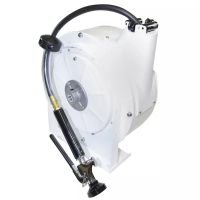67C Series
5
5. A clogged spring case vent hole may cause the
regulator to function improperly. To keep this vent
hole from being plugged (and to keep the spring
case from collecting moisture, corrosive chemicals,
or other foreign material) orient the vent to the
lowest possible point on the spring case or
otherwise protect it.
Inspect the vent hole regularly to make sure it is
not plugged. Spring case vent hole orientation may
be changed by rotating the spring case with
respect to the body. A 1/4 NPT spring case vent
may be remotely vented by installing obstruction-
free tubing or piping into the vent. Protect the
remote vent by installing a screened vent cap on
the remote end of the vent pipe.
6. For use in regulator shutdown, install upstream
block and vent valves and downstream block
and vent valves (if required), or provide some
other suitable means of properly venting the
regulator inlet and outlet pressures. Install a
pressure gauge to monitor instruments on startup.
7. Apply a good grade of pipe compound to the external
pipe threads before making connections, making sure
not to get the pipe compound inside the regulator.
8. Install tubing tting or piping into the 1/4 NPT inlet
connection on the body (key 1) and into the
1/4 NPT body outlet connection.
9. The second 1/4 NPT outlet can be used for a
gauge or other use. If not used, it must be plugged.
When installing a 67CF Series regulator in an existing
installation, it may be necessary to use spacers
(key 34, Figure 13) to adapt the installation. If the
mounting bolts are too long, place a spacer on the
bolt (see Figure 13). To be sure the regulator is
secure, the bolts should have at least two full threads
of engagement.
Key numbers are referenced in Figures 3 through 9.
1. With proper installation completed and downstream
equipment properly adjusted, slowly open the
upstream and downstream shutoff valve (when
used) while using pressure gauges to monitor pressure.
!
2. If outlet pressure adjustment is necessary,
monitor outlet pressure with a gauge during the
adjustment procedure. The regulator is adjusted
by loosening the locknut (key 18), if used, and
turning the adjusting screw or handwheel (key 19)
clockwise to increase or counterclockwise to
decrease the outlet pressure setting. Retighten the
locknut to maintain the adjustment position.
First, close the nearest upstream block valve and
then close the nearest downstream block valve
(when used). Next, open the downstream vent valve.
Since the regulator remains open in response to the
decreasing downstream pressure, pressure between
the closed block valves will be released through the
open vent valve.
Regulator parts are subject to normal wear and
must be inspected and replaced as necessary. The
frequency of inspection and replacement of parts
depends on the severity of service conditions and
applicable codes and government regulations. Open
the Type 67CF, 67CFR, 67CFS, or 67CFSR drain valve
(key 2) regularly to empty accumulated liquid from the
dripwell (key 5).

